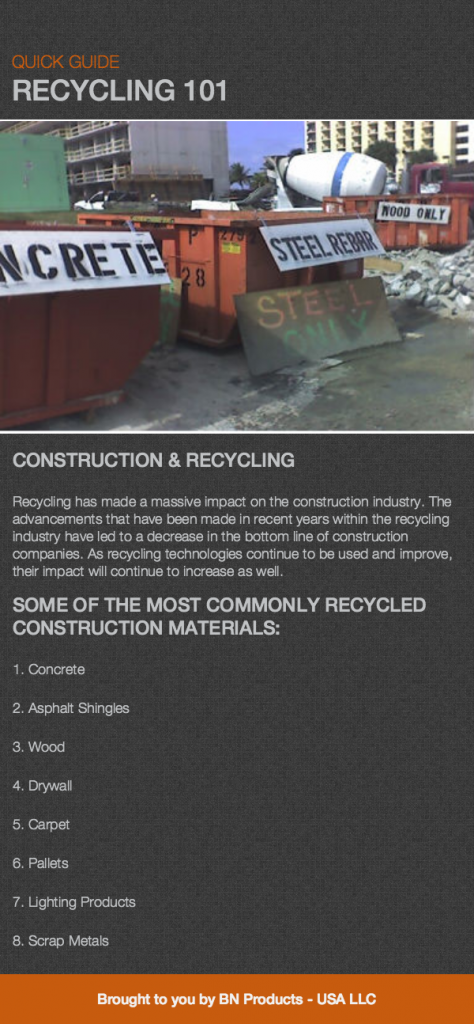
Recycling has made a massive impact on the construction industry. The advancements that have been made in recent years within the recycling industry have led to a decrease in the bottom line of construction companies. As recycling technologies continue to be used, their impact will continue to increase as well.
The need for re-usable materials is on the rise as well. As recycling and re-use become more synonymous with the construction industry, we will begin to see its positive effects on both the environment and the economy.
This is truly a case where small changes can result in large-scale impacts across an entire industry.
What Kinds Of Construction Materials Are Actually Recyclable and Re-usable?
When it comes to the kinds of materials that are actually re-usable, the scope is very large. As the recycling and construction industries continue to become more intertwined, the number of re-usable and recyclable materials will grow in scale.
There is a significant amount of waste material that is generated from the construction and demolition industries. A large amount of this material, such as metal wiring and piping, wood, rebar, and drywall, used to be considered waste. However, with today’s recycling technology, much of this material can be re-used and repurposed today.
Below we have outlined some of the most commonly recycled construction materials:
1. Concrete
Over 140 million tons of concrete are recycled every single year. This helps to divert a lot of waste that would usually end up in the landfill.
2. Asphalt Shingles
Asphalt shingles used to generate a ton of waste. However, today, much of that waste is instead reused or processed and resold.
3. Wood
Wood waste is one of the largest components of construction waste after cement. This is why it is crucial to recycle and reuse wood as often as possible.
The composition of wood waste is much different from other types of construction waste. This makes the reuse of wood a little more difficult, however this does lead to increased flexibility. For example, as part of the green recycle movement, it has become trendy in the interior design industry to incorporate recycled wood into home renovations, due to the wood’s distinctive distressed and aged characteristics.
4. Drywall
A lot of drywall today is made from Gypsum. This material is relatively easy to breakdown and reuse, both aspects which make its case to be a truly green product.
5. Carpet
Since 2002, carpet recycling has doubled, which illustrates that the need for it is there. Especially, as more efficient forms of recycling become available to repurpose the previously discarded product.
6. Pallets
Wooden pallets used to be a huge contributor to the overall volume of construction waste. However, pallet reuse is continuing to grow as third party companies start to extend their offerings. Today, there are companies that pick up used pallets from a job site, and re-distribute them to other construction sites in the area.
7. Lighting Products
Old lights and light fixtures used to take up a lot of space in landfills. More recently, a lot of local counties and municipalities are starting to introduce lighting and lighting fixture recycling programs.
8. Scrap Metals
The scrap metal market has been operating for a long time and is very well-established. This makes is fairly easy to recycle your own scrap metal, and purchase from suppliers who sell recycled or reused metal.
How Often Are Recycled Materials Re-used?
There are a wide variety of markets for recycled materials. Materials that have been salvaged from construction sites can also be used beyond the construction industry.
• Concrete can be used for a wide array of markets. For instance, concrete can be used in markets that utilizes crushed stone.
• Asphalt is usually recycled back into asphalt, either in-place or hot-mix asphalt. Asphalt shingles can also be used for hot-mix asphalt. The energy savings produced by asphalt recycling are very large.
• Wood that is untreated can be recycled into a variety of materials. For example, untreated wood can be milled down into lumber, or chipped and made into engineered board and more.
• The most commonly found metals on a construction site are aluminum, steel and copper. Local scrap yards and recyclers that have these metals available or accept them have been established for years.
• The gypsum that is within drywall can be removed and recycled for any market that uses gypsum, such as the cement, agriculture and drywall manufacturing markets.
• Cardboard recycling markets are already well established, as construction sites generate a large amount of cardboard waste from receiving new materials and shipments.
As you can see, waste is commonly recycled and reused within the construction industry and even extends out into other markets as well. This makes the construction and recycling industries strong partners vested in improving and revolutionizing green technologies together.
If you are interested in learning more about green construction, read our recent post on What You’ve Always Wanted To Know About Green Building, and Tips on Recovering and Recycling Rebar.


